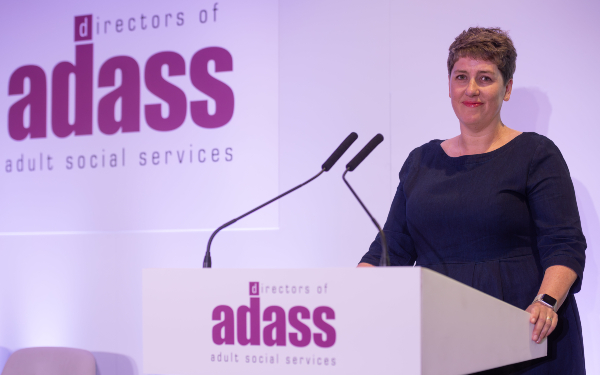
Photo: fizkes/Adobe Stock
Overspending on adult social care budgets hit a 10-year high last year, in part due to costs being shunted onto councils as a result of NHS cuts, including to continuing healthcare, directors have reported.
The Association of Directors of Adult Social Services’ (ADASS) annual spring survey also revealed that councils had cut spending on preventive services on the back of increasing demand for care and rising complexity of need.
At the same time, more carers were approaching councils in need of support due to a breakdown in their ability to support loved-ones, while most directors lacked full confidence that they would be able to meet the care and support entitlements of people in their areas this year.
Following the survey report’s release, ADASS warned councils were having to “choose between helping people with complex needs now and preventing others from getting unwell” and called for a significant boost in government investment in adult social care.
Highest overspend in a decade despite funding boost
The ADASS survey, which ran from 30 April to 6 June 2025 and received 139 responses from the 153 English local authorities, covered councils’ spending in 2024-25 and budgets for 2025-26.
Reflecting Ministry of Housing, Communities and Local Government (MHCLG) figures, the survey revealed councils had planned significant rises in spending in both years, with net budgets set at £20.8bn for 2024-25 – £1bn above actual spend in 2023-24 – and £22.4bn – a further increase of £1.6bn – for 2025-26.

Photo: chrupka/Adobe Stock
However, despite the rise in planned expenditure in 2024-25, councils overspent their adult social care budgets by £774m (3.46%), the highest overspend recorded by ADASS in a decade.
Four in five authorities (80%) breached their budgets in 2024-25, up from 72% in 2023-24 and 63% in 2022-23, when the national overspend was just £73.7m.
Councils making almost £1bn in adult social care savings this year
And despite the significant boost in planned expenditure for 2025-26, councils are having to make £932m in savings in order to balance their budgets, the highest level recorded by ADASS since 2016-17.
Only 16% of directors were fully confident that they would achieve their savings target, with 74% partially confident and 5% not confident at all.
At the same time, just 24% of authorities were fully confident that they had the budget to meet the care and support of older people in their areas, as required by the Care Act 2014, with 67% partially confident and 9% not confident at all.
In relation to adults aged 18-64, 21% of authorities were fully confident they had the budget to meet their care and support entitlements, with 67% partially confident and 12% not confident at all.
Continuing healthcare squeeze shunting costs to councils
A key cause of the 2024-25 overspend, and expected spending pressures in 2025-26, was a shift in responsibility for services from the NHS to adult social care, including in relation to continuing healthcare (CHC).
CHC is a package of NHS-funded health and social care provided to people assessed as having a “primary health need”, either by a single health professional, for people who may be nearing the end of life, or a multidisciplinary team including a social care practitioner. Where people are found to be ineligible for CHC, or lose eligibility, their social care costs must be picked up by the relevant local authority and/or the person themselves.
The number of people receiving CHC fell from 53,193 in June 2024 to 51,582 in March 2025, while the percentage of those deemed eligible following standard CHC assessments dropped from 20% in the first quarter of 2024-25 (April to June 2024) to 18% in the final quarter (January to March 2025), according to NHS England data.
ADASS found that:
- 75% of directors saw a rise in new requests for adult social care from people previously eligible for CHC, while 73% said there had been an increase in requests for care home placements for people with more complex needs due to a tightening of CHC eligibility.
- 49% said there had been a decrease in the number of people qualifying for CHC in their areas while 64% said there had been a rise in social care staff providing clinical oversight to people with a primary health need in the absence of an agreement to provide them with CHC.
- 73% of directors reported an increase in council overspends due a tightening of CHC eligibility.
Adult social care ‘increasingly absorbing previous NHS responsibilities’
ADASS also found there were other respects in which adult social care was “increasingly absorbing responsibilities previously delivered by health partners”, including the delegation of healthcare tasks. This involves a health professional, like a nurse, transferring responsibility for a healthcare activity to a social care worker, something the government is promoting.

Photo: LIGHTFIELD STUDIOS/Adobe Stock
Three-quarters (74%) of directors reported an increase in social care staff carrying out delegated healthcare tasks in their areas, with 18% seeing a big rise. However, just 26% of directors were satisfied that health partners were providing the necessary resource to ensure delegated healthcare tasks were commissioned on a planned and safe basis, with 49% dissatisfied.
Similarly, just 16% were satisfied that care workers undertaking delegated healthcare tasks were appropriately remunerated, with 48% dissatisfied.
Furthermore, 100% of directors agreed that shifts in NHS responsibilities would be a source of additional pressures on adult social care in 2025-26.
Rising demand and complexity of need
However, the survey revealed that councils were facing a range of other pressures on their adult social care services, including rising demand and complexity of need.
Just over three-quarters of directors reported an increase in people presenting to adult social care in the previous 12 months after being discharged from hospital, with 58% saying they had faced a hike in demand from people referred from the community. In relation to areas of need, 73% had seen a rise in mental health referrals, 60% an increase in rough sleeping presentations and 55% a growth in domestic abuse-related referrals.
At the same time, 63% of councils reported a rise in the average size of care packages for people discharged from hospital in the previous 12 months, with 60% saying the same about people drawing on care and support in community-based settings.
In relation to pressures on their 2025-26 budgets, 89% of directors were concerned about rising costs due to increasing complexity of need in relation to older people, while 95% were similarly concerned in relation to working-age adults services.
Provider wage and tax rises not fully funded
Another source of pressures facing adult social care in 2025-26 is the 6.7% rise in the national living wage (NLW), paid to hundreds of thousands of care workers, and the increase in the rate of employers’ national insurance contributions, from 13.8% to 15%, along with the lowering of the salary threshold at which this is paid.

Photo: syahrir/Adobe Stock
According to think-tank the Nuffield Trust, the rises will cost independent adult social care providers an extra £2.8bn in 2025-26, with councils liable to cover £2bn of this.
However, despite care providers requiring increases in their fees from councils of 8-10% as a result of these measures, ADASS found that the average hourly fee paid by councils for home care in 2025-26 – £23.85 – was just 5.2% higher than the £22.68 reported at its 2024 spring survey.
While it stressed that such a national average should be treated with caution, ADASS said it was well short of the Homecare Association’s calculation of the minimum price for home care per hour required to cover the NLW for care staff, £32.14.
“The full consequences of these cost increases for the sector, alongside local authorities’ inability to offset them, are likely to play out over the coming months and years,” said ADASS. “There will be risks to market sufficiency, but also to quality and longer-term investment.”
Cuts to prevention
As well as not being able to cover providers’ increased costs, ADASS also found that councils planned to cut spending on preventive services by 11.6% in 2025-26, from £1.43bn to £1.27bn, following a 7.7% cut in expenditure on early intervention in 2024-25.
Consequently, spending on prevention as a percentage of budget fell from 7% in 2024-25 to 5.6% in 2025-26, the lowest level yet recorded by ADASS, a trend which the association attributed to the need “to prioritise those people with the highest level of need”.
The Care Act requires councils to provide services to prevent, delay or reduce needs for care and support in their area, as well as to promote wellbeing in the discharge of their adult social care functions. However, 74% of directors were less than fully confident they would be able to meet these duties in 2025-26, up from 51% in 2024-25.
The situation comes despite shifting NHS services from treating ill-health to preventing it being one of three key priorities for the government in its reforms to the health service, which involve creating so-called neighbourhood health services that include social care practitioners.
Rising pressures on carers
The survey also revealed mounting pressures on unpaid carers, with 41% of directors seeing an increase of more than 10% in requests for support from carers and 35% reporting a less-than-10% rise.
In relation to requests that followed a breakdown in a carer’s ability to care for their loved-one, 20% of directors reported a rise of more than 10% and 34% a rise of less than 10%.
The biggest factor driving breakdowns was carer burnout, which 52% of directors said was present in at least most cases. In the light of the findings, almost all directors backed the introduction of paid leave from work for carers and an expansion of eligibility for carer’s allowance, the main benefit for the group.
Falls in waiting times and increases in home care hours delivered
More positively, the survey report estimated that, from March 2024 to March 2025, the number of people waiting for an assessment, care package, direct payment or review fell from 418,029 to 372,113, a drop of 10.9%.
In relation to assessments specifically, the numbers waiting more than six months dropped by 28.5%, from an estimated 78,641 in March 2024 to 56,249 in March 2025.
At the same time, the number of home care hours funded by councils rose by 5.8% from January-March 2024 to January-March 2025, when it totalled an estimated 47,594,699, which ADASS found had been enabled by a boost to staffing capacity.
‘The maths doesn’t add up’ – ADASS president

Jess McGregor, ADASS president, 2025-26 (credit: Matthew Power Photography)
However, despite these plus points, ADASS president Jess McGregor warned: “The maths simply doesn’t add up – more people are coming to councils for help and their care is complex and costly, which means we don’t have funds left to provide the early support and prevention that would stop people’s health from deteriorating and help them avoid spiralling into crisis, where they frequently end up in hospital.
“We shouldn’t have to choose between helping people with complex needs now and preventing others from getting unwell – we need to support people at both ends of the social care spectrum. But without more investment to keep people well and independent at home, we risk undermining the shift towards prevention and neighbourhood health that Wes Streeting, the NHS and this government are rightly championing.”
The government has claimed that, through its spending review, councils will have £4bn a year more available to spend on adult social care in 2028-29 than 2025-26. However, ADASS said this did not account for the increasing costs councils were facing, while there was uncertainty over whether some of it would be used to fund the planned fair pay agreement for adult social care, which the association said was “much needed but costly”.
NHS transformation ‘requires social care investment’
For the NHS Confederation, chief executive Matthew Taylor said: “As NHS leaders are well aware the transformation needed towards neighbourhood-based care can only succeed if this is coupled with sustained investment in adult social care.
“Every day, social care staff support hundreds of thousands of people to live more independent and fulfilling lives, while also helping to ease pressures on stretched NHS services. Health and social care services are interdependent, without a robust social care sector, the NHS cannot function effectively, and population health outcomes will continue to suffer.”
The ADASS findings come with the Independent Commission into Adult Social Care, led by Baroness (Louise) Casey having started work on drawing up proposals for the long-term reform of adult social care.
The commission, set up by government, will produce an initial report next year setting out a 10-year reform plan, with a further report to follow by 2028.
link
